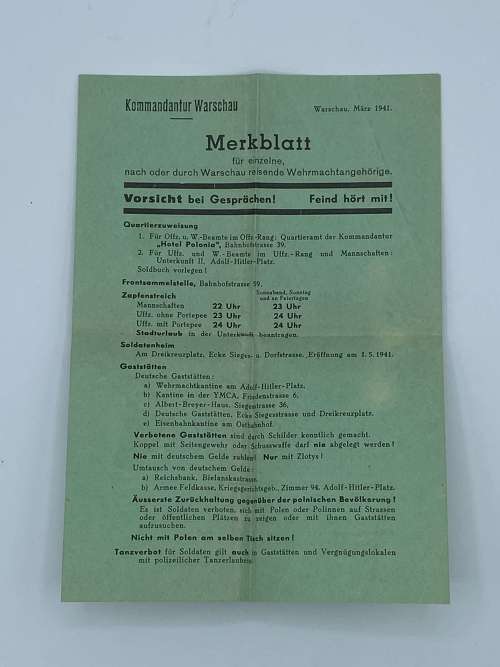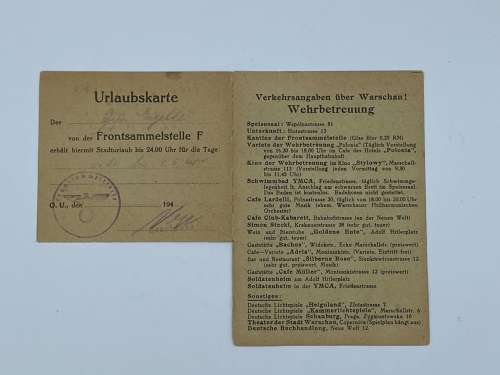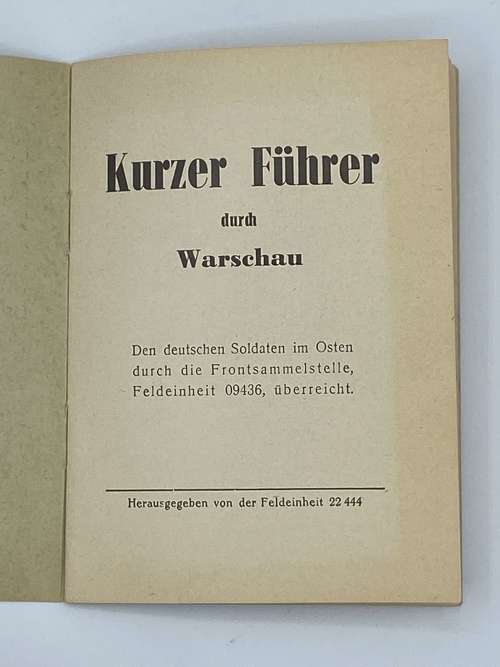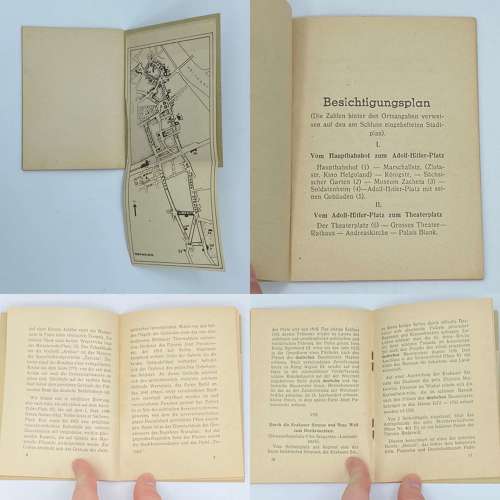
Dealer Information
Dealer: Atlas AntiquesLocation: United Kingdom
Tel: 7908974547
Email: joshatlafdsfdssantiques@gmail.com
 |
Dealer InformationDealer: Atlas AntiquesLocation: United Kingdom Tel: 7908974547 Email: joshatlafdsfdssantiques@gmail.com |
|
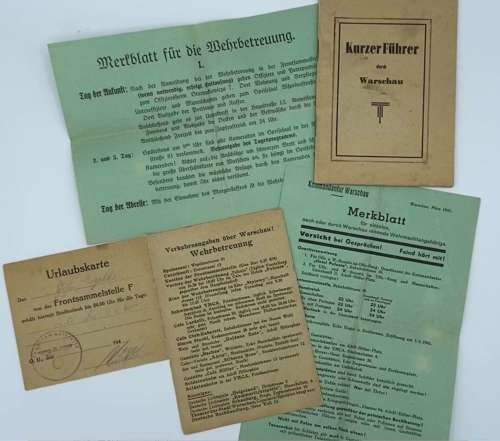
Code: 10934
For sale is a Rare WW2 German Wehrmacht Paperwork Stationed In Warsaw 1941. In this lot are four pieces of paperwork, a 1941 dated german guide to Warsaw, March 1941 Warsaw Headquarters Information sheet for individual members of the Wehrmacht traveling to or through Warsaw green leaflet, 1941 dated Warsaw vacation card and a 1941 Leaflet for military support Day of arrival green sheet. These are incredibly rare documents! (These will be sent via special delivery and dispatched within two to three working day’s) guaranteed original or money back. Rough translations are below:
Front:
Warsaw, March 1941. Warsaw Headquarters Information sheet for individual members of the Wehrmacht traveling to or through Warsaw. Be careful with conversations! Enemy hears with! Allocation of quarters. For officers and Off-ranked civil servants: Quartieramt der Kommandantur "Hotel Polonia", Bahnhofstrasse 39. - For Uffz. And civil servants of the Uffz. Rank and teams: Accommodation II, Adolf-Hitler-Platz. Present paybook! , Bahnhofstrasse 59.Saturday, Sunday and public holidays Zapfenstreich teams Uffz. Without Portepee 11 p.m. Uffz, with Portepee apply for a city holiday in the accommodation. 10 p.m. 11 p.m. 12 p.m. midnight 12 p.m. Soldiers' home on Dreikreuzplatz, corner of Siefes, i. Dorfstrasse. Opening on 1.5, 1941. Restaurants German restaurants: a) Wehrmacht canteen at Adolf-Hitler- Platz, b) Canteen in the YMCA, Friedenstrasse 6, c) Albert-Breyer-Haus, Siegestrasse 36, d) German restaurants, corner of Siegesstrasse and Dreikreuzplatz, e) Railway canteen at the Ostbahnhof. Prohibited restaurants are indicated by the signs. Belt with side rifle or firearm must never be removed! Never pay with German money Only with zlotys! Exchange of German money a) Reichsbank, Bielan skastras b) Army field treasury, Kriegsgeriatsgeb., room 94, Adolf-Hitler-Platz. Extreme restraint towards the Polish population! It is forbidden for soldiers to show up with Poles in the streets or in public places or to go to restaurants with them. Don't sit at the same table with Poles! Dancing for soldiers is also prohibited in restaurants and entertainment venues with a police license to dance.
Back:
Cinema Helgoland. Zlotastrasse Kammerlichtspiele, Schauburg. Praga. Sigismundstr until 11.30 a.m. Stylowa, Marschallstrasse 112 banned by 15 members of the armed forces. All seats in the car and on the platforms can be used. It is recommended to use two single tickets. a) Entering the closed-off Jewish residential area at any time. Entering the other cinemas for the tram Price: one-way trip 0.15 zloty, ase card 0.35 zloty. In the case of one-time, preferably front is prohibited! Driving through on the tram is permitted, but b) There is a risk of sexually transmitted diseases in Warsaw. Family and in front of his people take responsibility for his own health c) Tap water may only be boiled! d) Local hospital I, Solecstrasse 93: For accidents, surgical, eye, ear, nose and internal diseases, dental treatment. Local hospital II. Königsstrasse, near Adolf-Hitler-Platz: 1. Epidemics and internal diseases. Dental treatment. III. 6. Sierpniastrasse 33/35: Local hospital for surgery, skin and sexually ill people. Bathing in Polish baths and in the Vistula is prohibited! Swimming for members of the Wehrmacht Indoor swimming pool: in the YMCA, Friedenstrasse 6 Open swimming pool: in the Wehrmacht Stadium, Hafenstrasse entrance at Lazienskowskastrasse. Church services Attending Polish services is prohibited, Wehrmacht services every Sunday at 10 a.m. in the Ev. Garrison Church, Feldherrnallee. Flak barracks Mokotow, and in the Catholic Garrison Church on Krasinskichplatz. Suit Every soldier must be aware that he has to represent the reputation of the German Wehrmacht in relation to the hostile large town in his posture and in his suit (a molten collar is prohibited) on the street. Larger groups of members of the military service have to take this into account. Strolling around in disordered, traffic-hindering heaps is prohibited. Road traffic The provisions of the road traffic regulations must be observed. Pay particular attention to the maximum permitted speeds. No more than 40 km in built-up areas. drive. Report traffic accidents to T. and the commandant's office immediately. uppe alcohol consumption vodka is dangerous, drunkenness often leads to the heaviest punishments. The commandant signed: V. Unruh
Frontsammelstelle (Vacation) Card:
Front assembly point for armed forces Officer accommodation: Starynkiewicza 7 Dining room for men: Wspólna 81 Accommodation: Hoża 13 (see map) Defe Rank Name 25334 Unit: 6 MAJ. 1941 arrival: 9 V. 1941 departure :.
ezImaiyuhjeis Lindleya Str. Tr Chałubinskie9 Ar Emilji Plater Str. AL DL Marschallstr. ---- HaM anan Hauptbahnhof front collecting point Bahnhofstr. Nowogrodzka St. Wspólna St. Dining room house no. 13 Accommodation officers' home at Hoźa St.
Vacation card The person from the front collecting point F hereby receives city vacation until midnight for the days: O. U., 194
Traffic information about Warsaw! Military service dining room: Wspólnastrasse 81 Accommodation: Hożastrasse 13 Canteen of the front collection point (glass of beer 0.25 RM) Variete of the military service "Polonia" (daily performance from 4.30 to 6.00 pm in the cafe of the hotel "Polonia". Opposite the main station) Military service cinema in the "Stylowy" cinema, Marschallstrasse 112 (show every morning from 9.30 am to 11.45 am) YMCA swimming pool, Friedenstrasse, daily swimming opportunities as posted on the notice board in the dining room Free of charge. Swimming trunks are not permitted. Cafe Lardelli, Polnastrasse 30, very good music daily from 6.00pm to 8.00pm (former Warsaw Philharmonic Orchestra) Cafe Club-Cabaret, Bahnhofstrasse (on the New World) Simon Stecki, Krakauerstrasse 38 ( very good, expensive) wine and pub, Goldene Ente ", Adolf Hitlerplatz (very good, expensive) restaurant" Bachus ", Widokstr., corner of Marschallstr. (inexpensive) Cafe-Variete Adrla", Moniuszkistr, (variety, free entry) bar and restaurant, Silver Rose ", Sienkiewiczastrasse 12 (very good, inexpensive, music) Restaurant" Cafe Müller ", Moniuszkistrasse 12 (inexpensive). Soldiers 'home at Adolf Hitlerplatz Soldiers' home in the YMCA, Friedenstrasse Other: German light plays "Helgoland", Złotastrasse 7 German light plays, chamber light plays ", Marschallstr. 6 Deutsche Lichtspiele Schauburg, Praga, Zygmuntowska 10 Warsaw City Theater, Copernica (the program is hanging) Deutsche Buchhandlung, Neue Welt 12.
Green leaflet hard to read:
Front:
Leaflet for military support. I. Day of arrival: After registering with the armed forces support in the front assembly point (if necessary, escape takes place), officers and porters go to the officers' home Staryniewicza 7. There, accommodation and meals. NCOs and man switches go to the dining room at Wſpolnastraße 81. There, the serving of the portion and coffee. Then it goes to the incident at Hozastraße 13. Instructions for the room and delivery of de Deden and bed linen by the guard. After that, free time until midnight. At 900 o'clock all comrades were gathered in the dining room at 81 Wfpolnaitraße. Announcement of the daily program. Comrades! Pay attention to the notices on the bulletin board and look at the large overview card vol 2Warſchau, which is hanging in the dining room. Rejenders takes note of the munije request from the comrade in the armed forces. 2nd and 3rd day: care, so that you do not miss anything. Day of the break: With the intake of the morning coffee, the military care is over.
Back:
The daily run of the 2nd and 3rd day. Weden: Weden at 7 am in the accommodation at Hozastraße 13. The bedrooms must be vacated by 8 am. Morning coffee: Coffee is served from 8 a.m. to 9 a.m. in the Opeisefaal Wſpolnaſstrasse 81 and the daily program is given there. Lunch is served at 12 noon in the dining room at Wipolnastraße 81. After lunch, free time; bed rest is recommended to all comrades. After bed rest, the beds need to be put back in order. Lunch: Evenings: Portions are only served in the dining room from 5:30 p.m. to 7:30 p.m., coffee or tea is served at the same time. Zapfenſtreich: evening leave daily until midnight; From 015 o'clock there is silence in all rooms of the accommodation.
Kurzer fuhrer:
Front:
Short guide to Warsaw
Pages:
Short guide through Warsaw Presented to the German soldiers in the east by the front assembly point, field unit 09436. Issued by field unit 22 444 Sightseeing plan (the numbers behind the location refer to the city map attached at the end). I. From the main train station to Adolf-Hitler-Platz Hauptbahnhof (1) str. Cinema Helgoland). scher garden (2) soldiers home (4) –Adolf-Hitler-Platz with its buildings (5). Marschallstrasse (Zlota- Königstrasse. Museum Zacheta (3) - - Sächsi- - II. From Adolf-Hitler-Platz to Theaterplatz Theaterplatz (6) - Big Theater- Rathaus Andreaskirche Palais Blank. III. Through the Senator and Honey Road to Krasiński Square, Ministry of Agriculture (7) puzinerkirche (8) richt) (9) –Erzbisch. Consistory-Greek - the Ka- Palais Parz (Landge | - Catholic Basilian Church, Catholic Garrison Church (10) - the Krasinskiplatz (11). IV. From Krasinskiplatz to the Old Market Ministry of Justice (11) Paulinerkirche (12) - Dominican Church (13) old town (14). V. The Old Market (15) Fuggerhaus. VI. Domhof and Cathedral (16) 4 VII. The Castle Square (17) The Castle (18) - the Sigismund Column. VIII. Through Krakauer Str. And New World to Dreikreuzplatz St. Anne's Church (19) (20) -Ministerial Presidium (Palais Radziwill) Hotel “Bristol” - Hotel “Eu- Karmeliterkirche ropa” Palais Potocki Church of the Visi- tesses (21) University-Copernicus- | Mal Staszichaus Kreuzkirche (22) - - - National and Army Museum (23) - St. Alexander Church (24). IX. Through the Siegesstr. To Seegarten and Belvedere The Lazienkipara (25) - the Lazienki Palace - Belvedere Palace. X. To the place of the Lublinerunion and to the Marschallstrasse aviator memorial Evangelical garrison church Mokotowerplatz Erlöserplatz (plac Zbawiciela) Polish Ministry of War. | Sightseeing of the city I. From the main train station to Adolf-Hitler-Platz From the main train station (1), which is still being developed as a central train station, past the vacant space at the corner of Bahnhofstrasse and Marshallstrasse, where before the war the head- train station “Wiener Bahnhof”, you get through Marschallstrasse (3rd side street on the right: Zlotastr. with the German film theater “Helgoland”) into Königstrasse. On the left side of Königstrasse is the Saxon Garden (2), which was laid out as a royal garden in 1713–1724 and has long been open to the public. A water tower in the shape of a Roman temple stands on a small hill. On the right hand after a short distance is Malachowski-Platz, (3). The corner building with the inscription “Artibus” is the museum of the “Zachęta” art promotion association. Behind it was the rotunda of a Protestant church from 1779, of which only the surrounding walls can be seen since the war. Also on the right-hand side, behind the destroyed building of the Polish Bank, is the German soldiers' home (4). We now turn north, i.e. to the left, and stand on Adolf-Hitler-Platz (5), which has been called this since September 1st, 1940. Before it was called Sachsen-Platz. A splendid Russian Orthodox cathedral made of white glaze with gilded, gleaming domes stood in Kier until 1925, which was torn down at the behest of Marshal Pilsudski. On the left is the building of the former Polish General Staff. In the middle of the two wings of the building stands the monument to Prince Josef Poniatow-Napoleon, designed by the famous sculptor Thorwaldsen, on Seitenski, who died fighting. The tomb of the Polish Unknown Soldier is located under the gallery, which connects the two wings of the building in 1813. Adjacent to this building is the architecturally perhaps most beautiful building in Warsaw, the Palais Brühl, which, built in 1641, has been rebuilt several times under various owners and has served various purposes. Most recently it was the seat of the Polish Foreign Ministry, from which the irresponsible plans directed against Germany originated. Today it is the official building of the governor of the Warsaw district. On the opposite side of the square are the city headquarters and the hotel "Europe", II. From Adolf-Hitler-Platz to Theaterplatz Turning past the Palais Brühl into Weidenstrasse, you come to Theaterplatz (6), the adornment of which, the Grosse Tlieater (opera house), occupies the entire south side . Built in the Empire style between 1825 and 1833, its burned-out walls make it, like all the ruins of this city, a loud accusation against the men who defended the open city of Warsaw in complete blindness in September 1939 The opposite side is dominated by the town hall, which was built in 1775 as the palace of the Jablonowski family. To the side of the theater is a monument to the Polish actor Boguslavski. The St. Andrew's Church forms the western end of the town hall front. It was built in Baroque style according to the plans of the German master builder Aigner. On the east side is the Palais des Bailkiers Blank, which is now the seat of the German city governor, 1 III. Through Senatorenstrasse and Honigstrasse to Krasinskiplatz. Passing Palais Blank, along Senatorenistrasse, you come to the ruins of the former Polish Ministry of Agriculture (7), an earlier palace of the Archbishops of Warsaw, the origins of which go back to 1613. Turning to the left, the path leads us to Honigstrasse, where there used to be many beautiful palaces that were converted into residential, commercial and official buildings in the 19th century. On the left side of the street there is the Basilica-style Capuchin Church (8), which King Johann Sobieski had built in memory of the liberation of Vienna from the Turks in 1683. House no. 11 is the palace of the Pazz family (9) from the year 1770. The rooms of the regional court no. 13 have been located here since 1831. It is a former archbishop's palace that now houses the archbishop's consistory. Opposite, through a pre-built 11 Canopy recognizable, is the Greek-Catholic. Basilian Church (built in 1784). At the corner of Honigstrasse and Lange Strasse is the German Kath. Garrison Church (10). Now the Krasinskiplatz (11) is in front of the spectator. It takes its name from the magnate residence of the Krasinski family (house no. 5). Built in 1676 1695, it was the highest tribunal during the Polish period. The palace of Count Badeni (house no. 1-3), built in 1883, was also used for court purposes. The monument of the shoemaker Kilinski, a Polish insurgent leader from 1794, stands on Square IV. Lonza Street continues eastwards past the Polish Ministry of Justice (11), a former palace of Count Raczynski, Fretstrasse On the right is the Church of the Pauline Monks (12) and diagonally opposite the Doninikanerkirche (13) The front is covered by an ugly apartment building. The Neustadtstrasse then leads us past the old, well-fortified city wall (14), which was only excavated in 1936 and restored to the Altmarkt. The remains of the old city wall remind us of old German city fortifications. If you look to the right or left into the snazzy side streets, you think you are seeing the streets of an old German town, as painted by the German painter Spitzweg in his pictures. The spirit of the German Middle Ages blows to us as we walk through these alleys. V. The old market. You see yourself completely transported to a German city when you enter the Old Market (15). The patrician houses with their gables and the layout of the market with its immediate surroundings undoubtedly have a German architectural character. From the beginning to the 18th century, the Old Market was the center of Warsaw which only shifted south and west in the 19th century. It has preserved the medieval character of the wealthy bourgeoisie in its patrician houses with their decorative portals, artistically forged doors, inscriptions, vaults and court arcades and is still described today as the most beautiful square in Warsaw in terms of style. However, no patricians live in the houses today, but Polish families. In 1928 all the houses were painted in a rich color, whereby the old patterns were preserved as far as possible. When entering the old market, we immediately see the corner house No. 29, which was once built by Masovian princes. House No. 27 is the well-known Fugger House, whose small courtyard is decorated with Renaissance arcades and balconies. VI. Cathedral courtyard and cathedral. The impression of the German spirit and influence in the Polish Middle Ages also accompany us through the Jesuiten-Strasse into the cathedral courtyard. The building style of the curia (houses of the canons) from the 17th century remind us of many a German bishopric. From the cathedral courtyard you get to St. Johannesstrasse. and stands in front of the front of St. John's Cathedral. (16). Originally a palace chapel of the Dukes of Masovia, it was expanded in 1370 and later became a metropolitan church. From the royal palace, an arched corridor leads to the cathedral over Domhofstrasse. A restoration in the years 1835–40 gave it the rather unattractive facade in the English Gothic style. VII. The Palace Square. After a few steps you come to Schloss-Platz (17), in the middle of which the 20 m high Sigismund Column towers, which King Wladislaus IV. In memory of the government of his father Sigismund III. has had it built. Has its current form the place only since 1818. The current castle (18), the ruins of which are again at the expense of the incompetent and inadequate political and military leadership of the Poles, let King Sigismund IIII. Built around 1620 in the basic shape of a pentagon according to the plans of the German master builder Hegner. After various demolitions, it was built by King August III. and added beautiful Rococo buildings to the unadorned front facade on the side facing the Vistula by German and Italian builders. The one on the access road to the Vistula Bridge, built in the 15th century, is remarkable. small palace, in which Prince Josef Poniatowski later lived. VIII. Through Krakauer Strasse and New World to Dreikreuzplatz. (Tram line 9 to Seegarten-Lazienki park). One of the busiest streets today, Krakauer Str., Starts from the Palace Square. famous German astronomers, whose German ancestry has been proven. have claimed the Poles as one of their own. On the right, Krakauer Strasse ends with the Kreuzkirche, to which a stone staircase leads up to a cross-bearing figure of Christ. The extension of Krakauer Strasse is the New World, which was important as a shopping street, but today has many ruins as a result of the Polish war. From the Postplatz, where the German main post office is also, a high-rise towers over all the houses as a symbol of Polish wholesaling addiction. Before the New World intersects Bahnhofstrasse, on the left, slightly indented, is the former palace of the Branicki family. The Bahnhofstrasse leads the bridge. Shortly before it stands the large National and Army Museum (23) built in 1932-33. To the New Over the Bahnhofstrasse, the New World leads to Dreikreuzplatz, which is a 19th A church modeled on St. Peter's Basilica, designed by the aforementioned German builder Aigner, which dominates St. Alexander's Church. (24). IX. Through the Siegesstrasse to the Seegarten and Belvedere. From here stretches to the Belvedere Palace VWarscliau's most beautiful street, the Siegesstrasse, on which on October 5, 1030 the parade of the victorious German trunks in front of the Führer and Colonel Be. Wehrmacht pen mistaken Small palaces, large villas, in front of which the took place. mostly inhabited by consulates and war embassies, line this street, on which the avenue park with the botanical garden extends eastward. Immediately adjacent to these green spaces is the magnificent lake garden (25). This consists of parts of an earlier zoo that King Stanislaus August Ponia- towski acquired in 1764, and 20 he expanded the Badesclılössclhen into a royal summer residence (26). In this romantic green idyll, apart from the Praclitsch! Össchen, the following are also noteworthy: the open-air theater on the island, the former cadet school, the white house and the hunting lodge of Prince Josef Poniatowski. The Belvedere Palace (27) is located in the immediate vicinity. Marshal Pilsudski lived and died here. Next to it is the Magdeburg house, in which Pilsudski von Auguşt 1917–9.11 1918 sat as a German prisoner of war. In 1938, this little house L'on was generously donated to the city of Magdeburg to Pilsudski and the city of Warsaw. X. To the place of the Lubl'ner Un'on and the Marschallstrasse. (Tram line 3 to the train station) The return hike is best done through Bagatelastrasse to the 21st Place of the Lublin Union with one not particularly (28). The Evangelical Garrison Church (29) is located near this square, on Feldherrnstrasse by the flak barracks. artistic aviator memorial The Mokotower Feld (airfield site) extends to the west. Marschallstrasse leads around the place of the Lubliner Union, on which the German chamber light theater is on the right. The heroes' graves of many comrades lie around Warsaw. You speak of the last and highest fulfillment of duty by the German soldier. The heroic death of the first commander-in-chief of the army, Colonel General Freiherr von Fritsch, is also connected with the battles for Warsaw. He fell on September 22, 1939 near Fw. Lewinow, a few kilometers from Warsaw. A memorial stone has been erected there. To visit the memorial stone one has to leave Warsaw in the direction of Bialystok. It stands close to the Warsaw – Radzymin road on Fw. Lewinow, five kilometers northeast of the northern Vistula bridge. new Germans From 1795-1806 it was owned by Prussia as the capital of what was then the province of South Prussia. In 1807 it became the capital of the Duchy of Warsaw, which was under French influence. In 1809 it was occupied by Austrian troops for 5 weeks after the Battle of Raszyn. In 1813, after the fall of Napoleon, Russian troops entered the city. 1815-1830 Warsaw was the capital of the Kingdom of Congress Poland created at the Congress of Vienna. Year 1830 after. Russian general Paschkiewicz conquered the city. The district of Żoliborz (named after the exclamation of a queen “Joli bord” - beautiful bank) was destroyed and the citadel was built here as a fortress against the Poles by order of Tsar Nicholas I. The Polish insurgents were held prisoner in the notorious Pavilion X and the death sentences were carried out. Marshal Pilsudski also sat here as a Russian prisoner. 26th On August 5, 1915, Warsaw was captured by German troops from Prince Leopold's Army of Bavaria; it remained occupied until November 9, 1918. From that time it was the capital of the newly created Polish republic, until Polish generals with Rydz-Smigly and Polish politicians with Foreign Minister Beck at the head ns as mercenaries in England's world domination plans. lands in their megalomania the new world unleashed the war. In a “blitzkrieg” of 18 days, the Polish army was defeated and wounded up. The defenders of Warsaw refused to surrender the city and tried senseless resistance. After a brief siege and bombardment, German troops marched into the city on October 1st. This is how Warsaw played out its role as the capital. The German Governor General now administers the German area of interest as Ne- 27 build a magnificent castle in Wilanow (about 9 km south of Warsaw). In 1702 Warsaw was once again the warlike Tunimelplatz of the Swedes when Charles XII. indented here. Contributions, fires and the plague depopulated the city. The Sejm Marshal Bielinski (1742-66), after whom the Marschallstrasse is named, began to expand the city in Europe; the streets were paved and lighted. The further expansion of the city fell during the reigns of August II (1697-1733) and August II (1733–63), which they again enriched with beautiful baroque and rococo buildings, mostly by German architects. The last king, Stanıslaus August Poniatowski (1763–95), was the builder of architecturally significant buildings a. a. the splendid gem of the Lazienki castle. At that time Warsaw had around 100,000 inhabitants. 25th From 1795-1806 it was owned by Prussia as the capital of what was then the province of South Prussia. In 1807 it became the capital of the Duchy of Warsaw, which was under French influence. In 1809 it was occupied by Austrian troops for 5 weeks after the Battle of Raszyn. In 1813, after the fall of Napoleon, Russian troops entered the city. 1815-1830 Warsaw was the capital of the Kingdom of Congress Poland created at the Congress of Vienna. Year 1830 after. Russian general Paschkiewicz conquered the city. The district of Żoliborz (named after the exclamation of a queen “Joli bord” - beautiful bank) was destroyed and the citadel was built here as a fortress against the Poles by order of Tsar Nicholas I. The Polish insurgents were held prisoner in the notorious Pavilion X and the death sentences were carried out. Marshal Pilsudski also sat here as a Russian prisoner. 26th On August 5, 1915, Warsaw was captured by German troops from Prince Leopold's Army of Bavaria; it remained occupied until November 9, 1918. From that time it was the capital of the newly created Polish republic, until Polish generals with Rydz-Smigly and Polish politicians with Foreign Minister Beck at the head ns as mercenaries in England's world domination plans. lands in their megalomania the new world unleashed the war. In a “blitzkrieg” of 18 days, the Polish army was defeated and wounded up. The defenders of Warsaw refused to surrender the city and tried senseless resistance. After a brief siege and bombardment, German troops marched into the city on October 1st. This is how Warsaw played out its role as the capital. The German Governor General now administers the German area of interest as Ne- 27 benland of the German Empire from the Polish royal castle, Wawel ”in Krakow. Today Warsaw has around 1,300,000 inhabitants.
Commercial vehicle printing, Warsaw


